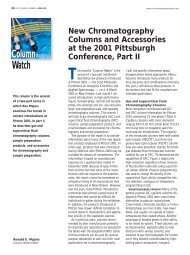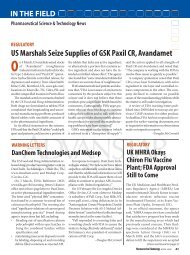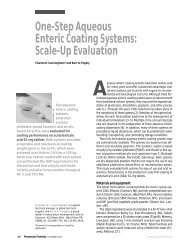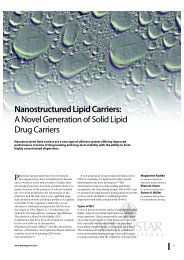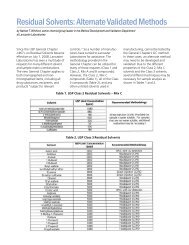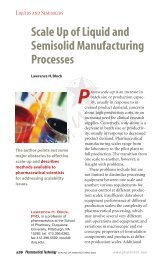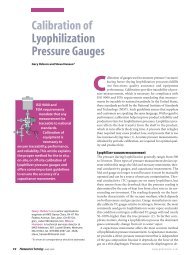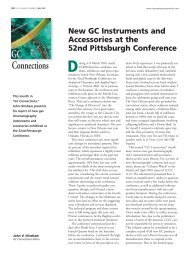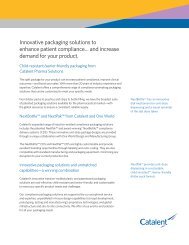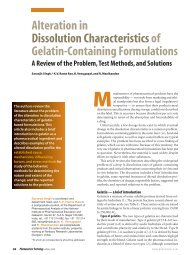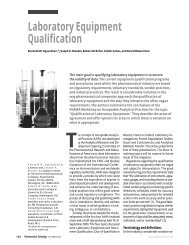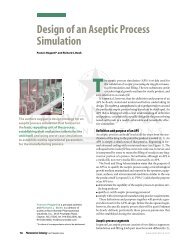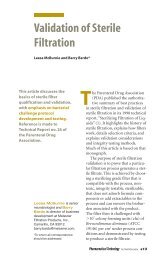Process Analytical Technology Concepts and Principles
Process Analytical Technology Concepts and Principles
Process Analytical Technology Concepts and Principles
You also want an ePaper? Increase the reach of your titles
YUMPU automatically turns print PDFs into web optimized ePapers that Google loves.
<strong>Process</strong> <strong>Analytical</strong><br />
<strong>Technology</strong><br />
<strong>Concepts</strong> <strong>and</strong> <strong>Principles</strong><br />
Mark L. Balboni<br />
<strong>Process</strong> analytical technologies are a<br />
multifaceted group of concepts that<br />
comprise one of many initiatives that form<br />
FDA’s “Pharmaceutical GMPs for the 21st<br />
Century.”Yet what constitutes a process<br />
analytical technology or whether it is in fact<br />
a new technology remains unclear. This<br />
article outlines the key concepts that define<br />
process analytical technology <strong>and</strong><br />
emphasizes the relevant theory <strong>and</strong><br />
applications of chemometrics.<br />
PHOTODISC, INC.<br />
Mark L. Balboni is a senior compliance<br />
consultant at KMI, a division of PAREXEL<br />
International, LLC, 28241 Crown Valley<br />
Parkway, F601, Laguna Niguel, CA 92677,<br />
tel/fax 949.830.2355, mbalboni@belmont.<br />
kminc.com.<br />
The current process analytical technology (PAT) initiative<br />
underway within FDA exemplifies the latest consortium<br />
between FDA <strong>and</strong> the industry that aims to encourage<br />
the concepts of quality by design, use of computerized<br />
data gathering <strong>and</strong> evaluation techniques, <strong>and</strong> process- <strong>and</strong><br />
product-monitoring methods through advanced instrumentation<br />
<strong>and</strong> data evaluation. Although this partnership between<br />
FDA <strong>and</strong> the industry is relatively new (2001), methods related<br />
to PAT such as chemometrics have been studied <strong>and</strong> have been<br />
in use for quite some time. Yet, the PAT initiative has raised several<br />
questions: What does PAT really encompass? Is it a new<br />
technology or is it a series of proven scientific principles? How<br />
can PAT be used in a pharmaceutical operation to gain better<br />
process underst<strong>and</strong>ing <strong>and</strong> possibly reduce cycle times <strong>and</strong> associated<br />
costs?<br />
This article discusses the concepts that embody PAT. Emphasis<br />
is placed on chemometrics, which is the use of mathematical<br />
<strong>and</strong> statistical models to extract <strong>and</strong> interpret chemical<br />
data.<br />
What is PAT?<br />
FDA defines PAT as<br />
● a system for the analysis <strong>and</strong> control of manufacturing<br />
processes based on timely measurements of critical quality<br />
parameters <strong>and</strong> performance attributes of raw materials <strong>and</strong><br />
in-process materials<br />
● a process to ensure acceptable end-product quality at the completion<br />
of the processing (1).<br />
FDA also states that PAT involves<br />
● the optimal application of process analytical chemistry (PAC)<br />
tools<br />
● feedback process-control strategies<br />
● information management tools <strong>and</strong>/or product–process optimization<br />
strategies for the manufacture of pharmaceuticals<br />
(1).<br />
In summary, PAT can be defined as the optimal application of<br />
PAC tools, feedback process-control strategies, information<br />
management tools, <strong>and</strong>/or product–process optimization strategies<br />
to the manufacture of pharmaceuticals.<br />
PAT focuses on the principles of building quality into the<br />
product <strong>and</strong> process as well as continuous process improvement.<br />
A few examples of PAT tools <strong>and</strong> strategies are as follows:<br />
54 Pharmaceutical <strong>Technology</strong> OCTOBER 2003 www.pharmtech.com
● at-line, in-line, or on-line measurement of process quality<br />
<strong>and</strong> performance attributes using a variety of instrumentation<br />
<strong>and</strong> measurement strategies such as near-infrared (NIR),<br />
vibrational, acoustical, <strong>and</strong> X-ray spectroscopy<br />
● chemometric approaches such as multivariate statistical <strong>and</strong><br />
pattern recognition methods.<br />
● real-time data <strong>and</strong> information management systems for<br />
process control (2).<br />
FDA’s PAT initiative is supported by many large pharmaceutical<br />
corporations <strong>and</strong> distinguished members of academia.<br />
Another potential advantage of PAT is the opportunity to<br />
place more reliance on in-process testing as the basis for final<br />
product release. This type of product-release methodology requires<br />
both a significant amount of data to be compiled <strong>and</strong><br />
heavy correlations to be determined by analysis <strong>and</strong> evaluation<br />
(3). The theory is that product release could be based on relationships<br />
(i.e., correlations between observed in-process test results<br />
<strong>and</strong> predictive qualitative results of the final product) established<br />
during product–process development <strong>and</strong> confirmed<br />
by both validation <strong>and</strong> routine review of product–process data<br />
for commercial lots. These relationships coupled with confirmation<br />
testing of the finished product would serve as the basis<br />
for release, or the product could possibly be released on the<br />
basis of the observed in-process results <strong>and</strong> how a currently<br />
produced lot favorably compares with other previously released<br />
product lots.<br />
FDA’s PAT initiative is being spearheaded by the Center for<br />
Drug Evaluation <strong>and</strong> Research (CDER), Office of Pharmaceutical<br />
Science. Since 2001, FDA has held <strong>and</strong> participated in a series<br />
of PAT meetings as part of the <strong>Process</strong> <strong>Analytical</strong> Technologies<br />
Subcommittee for the Office of Pharmaceutical Sciences<br />
<strong>and</strong> with the FDA Science Board. These meetings have included<br />
not only FDA personnel but also pharmaceutical industry representatives,<br />
members of academia, <strong>and</strong> engineering <strong>and</strong> consulting<br />
professionals.<br />
The PAT initiative is part of a larger FDA initiative called<br />
“Pharmaceutical CGMPs for the 21st Century: A Risk-Based<br />
Approach”(4). The agency seeks to improve the regulation of<br />
pharmaceutical manufacturing using a science- <strong>and</strong> risk-based<br />
approach to product-quality regulation while incorporating an<br />
integrated quality-systems approach.<br />
Complete descriptions of FDA’s PAT initiative <strong>and</strong> the “Pharmaceutical<br />
CGMPs for the 21st Century” approach, including<br />
electronic links to associated documents <strong>and</strong> reference materials,<br />
are provided in References 1 <strong>and</strong> 4.<br />
PAC <strong>and</strong> in/at/on-line monitoring<br />
According to Hailey et al., PAC is the technique of “gathering<br />
analytical information in real time at the point of manufacture”<br />
(5). As they noted, PAC “places an emphasis on the process<br />
rather than the final product,” including “an underst<strong>and</strong>ing of<br />
the relationship between final product specification [sic] <strong>and</strong><br />
the critical variables during the manufacturing process.”<br />
Although the approaches <strong>and</strong> instrumentation currently<br />
being discussed are in some cases categorized as being novel or<br />
new, real-time measurement (PAC) has existed for some time<br />
(e.g., real-time temperature monitoring of reaction vessels during<br />
the synthesis of active pharmaceutical ingredients). One<br />
particular industry–university partnership, The Center for<br />
<strong>Process</strong> <strong>Analytical</strong> Chemistry (CPAC) at the University of Washington,<br />
has been in existence since at least 1986 (6).<br />
Although PAC is not a new approach, many of the related<br />
techniques have been tested <strong>and</strong> used only on a limited basis<br />
by a very small percentage of the pharmaceutical industry. The<br />
following is a partial list of the various sensors <strong>and</strong> instrumentation<br />
recently discussed at the 2003 Arden House Conference<br />
either in-use or currently being evaluated for feasible use for<br />
production monitoring:<br />
● NIR spectroscopy for moisture determination<br />
● X-ray spectroscopy<br />
● radio frequency for moisture determination<br />
● microwaves for moisture determination<br />
● RAMAN spectroscopy, with vibrational spectroscopy being<br />
the most common. RAMAN complements IR spectroscopy<br />
<strong>and</strong> is used for raw-material identification, polymorph differentiation,<br />
<strong>and</strong> reaction monitoring.<br />
● fluorescence for water quality<br />
● on-line measurement of color<br />
● X-ray fluorescence for the detection of inorganic materials<br />
● photoacoustic spectroscopy.<br />
Because most of these technologies are extremely sophisticated,<br />
one must realize that the key emphasis of PAT is not so<br />
much how to collect the data or what kind of instrumentation<br />
should be used, but rather what data should be collected, what<br />
is done with these data, <strong>and</strong> what associated conclusions are<br />
reached. Therefore, a complete <strong>and</strong> thorough underst<strong>and</strong>ing of<br />
the manufacturing process is paramount.<br />
Chemometrics<br />
To fully underst<strong>and</strong> PAT, one must first underst<strong>and</strong> the science<br />
behind manufacturing processes, including how these processes<br />
operate, their limitations, <strong>and</strong> their expected outcomes.<br />
In 1974 Sante Wold, from the Institute of Chemistry at Umea<br />
University (Umea, Sweden) described “the art of extracting<br />
chemically relevant information from data provided in chemical<br />
experiments” as chemometrics (7). He stated that this art is<br />
“heavily dependent on the use of different kinds of mathematical<br />
models” <strong>and</strong> that it was important to have knowledge in<br />
statistics, numerical analysis, <strong>and</strong> applied mathematics, including<br />
the challenge to “structure the chemical problem to a form that<br />
can be expressed in a mathematical relation.”<br />
Twenty years later, during a 1994 presentation, Professor Wold<br />
said his definition of chemometrics had not changed much. He<br />
said chemometrics requires us to ask ourselves “How do we get<br />
chemically relevant information out of measured chemical data;<br />
how do we represent <strong>and</strong> display this information; <strong>and</strong>, how do<br />
we get such information into data?”<br />
In 1996, Wise <strong>and</strong> Gallagher stated chemometrics “is the science<br />
of relating measurements made on a chemical system to<br />
the state of the system via application of mathematical or statistical<br />
methods” (8). Similarly, Hardy noted that data are “raw<br />
information, both qualitative <strong>and</strong> quantitative” (9). He observed<br />
that in <strong>and</strong> of themselves, “raw data are meaningless” <strong>and</strong> that<br />
a method of “analysis <strong>and</strong> a model” are needed to “gain knowl-<br />
56 Pharmaceutical <strong>Technology</strong> OCTOBER 2003 www.pharmtech.com
edge” from the data. He also identified the clear need for a<br />
process to “convert data to knowledge.”<br />
Dosage forms recently have been described as “complex<br />
multifactorial physiochemical systems” (10), sometimes referred<br />
to as multivariate. Multivariate analysis “consists of<br />
methods of statistical analysis of multivariate data, characterized<br />
as consisting of several observations on each set of objects<br />
or mathematically represented by a collection of points<br />
in a finite-dimensional Euclidean space R P ” (11). So, multivariate<br />
analysis is an important statistical method widely used<br />
by chemometricians.<br />
Described below are a few of the tools commonly used by<br />
chemometricians, all of which are helpful for evaluating processing<br />
data generated during pharmaceutical unit operations<br />
or when synthesizing active pharmaceutical ingredients.<br />
Principle component analysis (PCA). PCA is a technique used to<br />
express variations of many variables by a small number of indicies<br />
(11). Wise <strong>and</strong> Gallagher describe PCA as a favorite tool<br />
of chemometricians for data compression <strong>and</strong> information extraction<br />
<strong>and</strong> note that “PCA finds combinations of variables or<br />
factors that describe major trends in a data set” (8). Sans et al.<br />
(12) observed that PCA can be used to determine the number<br />
of components that influence the data of the process as well as<br />
to identify the chemical meaning of the components. They proposed<br />
that PCA enables one “to approach multivariate chemical<br />
problems in order to obtain underlying information about<br />
the correlation of the raw data <strong>and</strong> the real meaning interpretation.”<br />
Finally, Wise <strong>and</strong> Gallagher (8) acknowledged that “generally<br />
there is a great deal of correlated or redundant information<br />
in process measurements,” <strong>and</strong> “often essential information<br />
lies not in any individual process variable but how the variables<br />
change with respect to one another” or how they co-vary. They<br />
also noted that “some sort of signal averaging” would be useful<br />
in cases in which a large amount of noise is created from the<br />
volume of data <strong>and</strong> a lack of clear underst<strong>and</strong>ing of the data<br />
exists.<br />
However, Wu et al. point out two limitations of PCA:<br />
● When an object is added or removed as displayed in a plane,<br />
principal components (PCs) must be recalculated all over<br />
again by following the process of selection <strong>and</strong> interpretation<br />
of the PCs.<br />
● No more than two PCs at a time can be viewed (inspected)<br />
in a plane, <strong>and</strong> this prevents one from using the information<br />
contained in other PCs (13).<br />
The authors also note that their “star-plot” method could be<br />
used as an alternative way to display <strong>and</strong> analyze multivariate<br />
data.<br />
Application of PCA to chemical processes. Wise <strong>and</strong> Gallagher (8)<br />
studied data obtained from a slurry-fed ceramic reactor using<br />
thermocouples placed at 20 locations (8). They found a great<br />
deal of correlation as the data generated followed a sawtooth<br />
pattern. In addition, the study revealed the following:<br />
● PCA performed on this data found three factors that captured<br />
approximately 97% of the variance in the data set.<br />
● This previously noted finding allowed 16 variables to be replaced<br />
with three new ones, which were linear combinations<br />
of the original variables.<br />
● The sawtooth pattern was attributed to changes in the level<br />
of molten glass, which was a controlled variable.<br />
● The three factors (PCs) were identified as the level of molten<br />
glass in the reactor, the variation between two groups of measured<br />
locations, <strong>and</strong> the variation of overall process temperature<br />
(also a controlled variable).<br />
Sans et al. also used PCA to determine stoichiometric models<br />
from on-line spectroscopy for selecting the number of reactions<br />
<strong>and</strong> the number of chemical absorbing species to better<br />
describe a chemical reaction (12). They chose to use<br />
spectroscopy methods because they can reveal information<br />
about the dynamic evolution of the reaction mass during a<br />
chemical reaction. Although the outcome of this study is not<br />
discussed in this article, Sans et al. did note that “semibatch<br />
processes are examples of complex reaction networks that generally<br />
are difficult to interpret because of the large number of<br />
reactions occurring simultaneously <strong>and</strong> because of the effects<br />
related to the addition of materials that may cause complex volume<br />
changes during the processing time.”<br />
Multiway principle component analysis (MPCA). An analog of PCA<br />
is what is known as multiway PCA, which is “equivalent to performing<br />
PCA on a very large two-dimensional matrix formed by<br />
unfolding the three-way array X into one of six possible ways,<br />
only three of which are mathematically unique” (8). General PCA<br />
methods do not take into account the ordered nature of the data<br />
sets, meaning that the data were not collected in a sequential<br />
manner. Multiway methods take into account the ordered (sequential)<br />
nature regarding when data were generated “because<br />
the data usually are organized into time-ordered blocks that are<br />
each representative of a single sample or process run” (8).<br />
Nomikos <strong>and</strong> MacGregor (14) describe another aspect of<br />
MPCA; namely, the use of on-line measurements to identify<br />
“significant deviations from the normal operating behavior by<br />
using SPC charts.” An empirical model is based on data generated<br />
when the process is operating within a state of control.<br />
They noted, “future unusual events are detected by referencing<br />
the measured process behavior against the ‘in-control’ model<br />
<strong>and</strong> its statistical properties.”<br />
Partial least squares (PLS). Wise <strong>and</strong> Gallagher described PLS<br />
as a regression “related to both principle component regression<br />
(regression of properties on the principle component scores of<br />
the measured variable) <strong>and</strong> multiple linear regression (also<br />
known as inverse least squares)” (8). They observed that this<br />
analysis can be used to predict “properties of a system based on<br />
variables that are only indirectly related to the property.” Accordingly,<br />
by using PLS, one attempts to “find factors” that both<br />
“capture variation <strong>and</strong> achieve correlation.”<br />
Multiway partial least squares (MPLS). Nomikos <strong>and</strong> MacGregor<br />
observed that MPCA using statistical process-control charts<br />
“only makes use of the process variable trajectory measurements<br />
(X) taken throughout the duration of the batch” (14). In contrast,“multiway<br />
partial least squares (MPLS) can be performed<br />
using both the process data (X) <strong>and</strong> the product quality data<br />
(Y),” <strong>and</strong> “focuses more on the variance of X that is more predictive<br />
for the product quality Y” (14).<br />
Other statistical tools. Two other statistical tools that may be<br />
useful in PAT efforts are<br />
58 Pharmaceutical <strong>Technology</strong> OCTOBER 2003 www.pharmtech.com
● capability studies, which measure the ability of the process to<br />
consistently meet specifications by evaluating select process<br />
outputs <strong>and</strong> calculating the average <strong>and</strong> ranges over a specified<br />
time on control charts. From these studies, capability indicies<br />
Cp (used to evaluate the variation) <strong>and</strong> Cpk (used to<br />
evaluate the centering of the process) are calculated.<br />
● design of experiments, which are experiments that involve<br />
changing one or more of the process inputs <strong>and</strong> measuring<br />
the results to one or more of the process outputs (15).<br />
Rapid microbiology test methods<br />
Another part of FDA’s PAT initiative involves discussion<br />
about the feasibility of developing so-called rapid microbiology<br />
methods (emphasis added, as most microbiological testing<br />
can take anywhere from several days to a couple of weeks<br />
to complete). This topic is of heightened interest within the<br />
industry as manufacturers seek additional ways to reduce cycle<br />
times.<br />
Rapid microbiology testing was discussed during the FDA<br />
Advisory Committee for Pharmaceutical Science meeting on<br />
23–24 October 2002 (16). During that meeting, the committee<br />
identified at least two problems or risks associated with the development<br />
of rapid microbiology methods; namely,<br />
● validation of test methods may not yield results equal to those<br />
for traditional test methods<br />
● acceptance by regulators (e.g., FDA).<br />
The group also categorized microbial determinations as follows:<br />
● qualitative methods (presence or absence of microbes; e.g.,<br />
sterility testing)<br />
● quantitative methods (enumeration of microorganisms present;<br />
e.g., microbial limits tests)<br />
● microbial identification.<br />
FDA did concede that rapid microbiology test methods are<br />
an important part of the PAT initiative but that at this time it<br />
has not yet been discussed extensively (16). FDA also commented<br />
that the general guidance document on PAT would not<br />
specify details about rapid microbiology methods but would<br />
rather cover them in a general sense to encourage their use. Finally,<br />
the group felt that microbial identification probably has<br />
the most rapid method systems presently available, <strong>and</strong> quantitative<br />
testing probably has the least detection systems.<br />
Real-time data information <strong>and</strong> management systems<br />
Another PAT tool being discussed is the use of real-time data<br />
information <strong>and</strong> management systems. Although a detailed<br />
overview of this topic is not provided in this article, some of<br />
the possible concerns include possible 21 CFR Part 11 implications,<br />
adding complexity to already complex computer system<br />
architecture, <strong>and</strong> the amount of data retention necessary, given<br />
that continuous monitoring will generate very large volumes<br />
of data.<br />
Circle/eINFO 45<br />
60 Pharmaceutical <strong>Technology</strong> OCTOBER 2003 www.pharmtech.com
With FDA’s recent withdrawal of Part 11 guidance documents,<br />
it would be advisable to first review the anticipated PAT guidance<br />
document for information concerning data information<br />
<strong>and</strong> management issues <strong>and</strong> secondly review the 21 CFR Part<br />
11 implementation portion of the “Pharmaceutical CGMPs for<br />
the 21st Century Initiative,” which includes both a Notice of<br />
Availability <strong>and</strong> a draft guidance on Part 11. The draft guidance<br />
on Part 11 attempts to clarify the scope <strong>and</strong> applicability of the<br />
regulation, which ultimately may undergo revision to clarify<br />
the scope <strong>and</strong> requirements.<br />
Benefits <strong>and</strong> challenges: an industry perspective<br />
Most industry representatives that either were involved in discussions<br />
regarding the feasibility of PAT or who have conducted<br />
successful PAT efforts thus far have had many more positive<br />
than negative comments regarding the advantages of adopting<br />
PAT principles. Positive perceived benefits of PAT include<br />
● decrease in cycle times<br />
● lower costs<br />
● increased efficiency <strong>and</strong> batch-to-batch consistency<br />
● process fingerprinting (signature) that would be useful for validation,<br />
scale-up, <strong>and</strong> confirming acceptable h<strong>and</strong>ling of changes<br />
● increased process underst<strong>and</strong>ing <strong>and</strong> a decrease in variability,<br />
rejects, <strong>and</strong> lot failures<br />
● possible continuous processing <strong>and</strong> the ability to adjust process<br />
on the basis of real-time monitoring data.<br />
Conversely, the most-common perceived or actual challenges<br />
include<br />
● product-approval delays by inclusion of PAT methodologies<br />
into relatively traditional drug development <strong>and</strong> validation<br />
activities<br />
● lack of a written PAT guidance document from FDA<br />
● an increase in the amount of data being generated, including<br />
not only what one should do with the extra data but also possible<br />
Part 11 implications<br />
● increased pressures to meet aggressive filing timelines, added<br />
costs to make changes, lack of senior management support,<br />
<strong>and</strong> resource constraints (Source: Reference 1 <strong>and</strong> 2003 AAPS<br />
Arden House Conference.<br />
Where we go from here<br />
Although no one can clearly predict how widely accepted PAT<br />
will become, it is clear that FDA does support innovation. The<br />
agency is appealing to the industry to take a more active role in<br />
underst<strong>and</strong>ing its manufacturing processes <strong>and</strong> is seeking quick<br />
<strong>and</strong> effective resolution of problems associated with good manufacturing<br />
practices that result in rejected batches, stability failures,<br />
field alerts, <strong>and</strong> product recalls.<br />
Currently there are many actions a company can take to<br />
prepare for what FDA is calling the “GMPs for the 21st Century.”<br />
By reading the contents provided on FDA’s Web site regarding<br />
PAT (http://www.fda.gov/cder/OPS/PAT.htm), which<br />
Circle/eINFO 47<br />
62 Pharmaceutical <strong>Technology</strong> OCTOBER 2003 www.pharmtech.com
includes committee meeting minutes <strong>and</strong> dozens of presentations,<br />
one will see that many large pharmaceutical firms already<br />
have made significant accomplishments through the<br />
successful implementation of PAT principles. In spite of the<br />
industry’s dwindling profit margins, fewer new products in<br />
the pipeline, <strong>and</strong> a more competitive marketplace, these companies<br />
already have recognized the positive aspects of implementing<br />
PAT. The following are some active steps that a company<br />
can take right now.<br />
Develop a plan for the future.<br />
● Wait for FDA’s much anticipated guidance document about<br />
PAT before making significant decisions regarding how your<br />
company will h<strong>and</strong>le certain PAT principles (e.g., validation<br />
of new analytical methods for a unique in-process test).<br />
● Analyze existing product lines <strong>and</strong> determine which may benefit<br />
most from PAT. For example, the compounding <strong>and</strong> filling<br />
of a well-established product that is a true solution composed<br />
of 99.5% water is probably not the best c<strong>and</strong>idate for<br />
PAT. The manufacture of complex dosage forms such as<br />
tableted products, which also includes in-process monitoring<br />
using process control charts, would probably be a better<br />
choice. Products with recurring quality problems are also<br />
good c<strong>and</strong>idates because process deviations or exceptions are<br />
sometimes results of a less-than-complete underst<strong>and</strong>ing of<br />
the process rather than more-obvious causative factors.<br />
● Obtain/retain employees with education, training, <strong>and</strong> experience<br />
in disciplines necessary to be successful in PAT efforts.<br />
For example, FDA is seeking to hire persons experienced in<br />
in-process/chemical engineering, PAC, chemometrics, <strong>and</strong><br />
industrial pharmacy. For your company’s efforts to be successful,<br />
similar expertise will be needed.<br />
● Gain executive management’s support for PAT. Although it<br />
may be easier to make the scientific case, management must<br />
underst<strong>and</strong> how PAT could reduce cycle times <strong>and</strong> costs <strong>and</strong><br />
add value. Make a business case for adopting PAT.<br />
Benchmark with industry <strong>and</strong> academic partners. Speak with<br />
company representatives from firms that already are using PAT<br />
principles. Many major universities also are heavily involved in<br />
the PAT initiative <strong>and</strong> could provide guidance, including, but<br />
not limited to, the following schools that have had representatives<br />
at several FDA committee meetings about PAT:<br />
● MIT Pharmaceutical Manufacturing Initiative<br />
● Purdue University, School of Pharmacy<br />
● Center for <strong>Process</strong> <strong>Analytical</strong> Chemistry at the University of<br />
Washington.<br />
● Texas A&M Department of Chemistry <strong>and</strong> Chemical Engineering.<br />
Gather information about the topic. A significant amount of information<br />
concerning PAT can be found on FDA’s Web site (1).<br />
Additional new information continues to be added, <strong>and</strong> plenty<br />
of information already is available on many university <strong>and</strong> industry<br />
association Web sites regarding topics such as PAT, PAC,<br />
Circle/eINFO 49<br />
64 Pharmaceutical <strong>Technology</strong> OCTOBER 2003 www.pharmtech.com
PCA, <strong>and</strong> chemometrics. Internet keyword searches can yield<br />
significant additional information.<br />
Attend future PAT workshops, seminars, or symposia. Find out<br />
what FDA <strong>and</strong> others are saying first-h<strong>and</strong>. If the workshops<br />
are sponsored by an industry association, you may need to attend<br />
in person to get the h<strong>and</strong>outs <strong>and</strong> presentations because<br />
all of that information may not be published on FDA’s or the<br />
association’s Web site.<br />
Provide comments directly to FDA using the Internet. If you have<br />
substantial comments regarding FDA’s PAT initiative <strong>and</strong> you<br />
feel it is information that others could benefit from, consider<br />
providing electronic comments to FDA. The agency already has<br />
established a Web-based feedback tool for this purpose (www.<br />
fda.gov/ohrms/dockets/). You will need to search for docket<br />
number 03N-0059. Alternatively, you could send questions or<br />
comments regarding the PAT initiative by email to<br />
pat@cder.fda.gov.<br />
Ensure quality is designed into your products <strong>and</strong> processes.<br />
● Confirm compliance with good manufacturing practices. Remember,<br />
CGMP is the minimum st<strong>and</strong>ard according to 21<br />
CFR 211.1(a). Most of the successful companies strive for <strong>and</strong><br />
achieve substantial compliance with these regulations as well<br />
as carry out “best practices.” Poorly developed manufacturing<br />
processes, untrained employees, or equipment that has<br />
not been properly qualified will hinder any PAT efforts.<br />
● Complete thorough product <strong>and</strong> process development work<br />
to ensure processes are adequately defined. Include robust<br />
specifications <strong>and</strong> critical process-control points.<br />
● Confirm that active drug substances are well characterized.<br />
● Use validation efforts to demonstrate consistency <strong>and</strong> reproducibility,<br />
not as a means to conduct range finding, process<br />
adjustments, or enhancements. These are development tasks,<br />
not validation.<br />
● Optimize processes <strong>and</strong> improve yields after successful validation,<br />
not during validation.<br />
● Consider process or equipment changes carefully, especially<br />
postapproval, because this usually will result in much unanticipated<br />
work <strong>and</strong> undoubtedly more development activities<br />
<strong>and</strong> data. Complete risk or impact assessments on the<br />
basis of data <strong>and</strong> not on opinions or theories.<br />
Many years ago, Alex<strong>and</strong>er Hamilton said,<br />
Experience teaches that men are often so much governed<br />
by what they are accustomed to see <strong>and</strong> practice, that the<br />
simplest <strong>and</strong> most obvious improvements, in the most<br />
ordinary occupations, are adopted with hesitation, reluctance,<br />
<strong>and</strong> by slow gradations. Men would resist<br />
changes, so long as even bare support could be ensured<br />
by an adherence to ancient courses, <strong>and</strong> perhaps even<br />
longer.<br />
Sometimes changes do take time, so we should look to the<br />
future potential of PAT to enhance our pharmaceutical processes<br />
Continued on page 254<br />
Circle/eINFO 51<br />
66 Pharmaceutical <strong>Technology</strong> OCTOBER 2003 www.pharmtech.com
Continued from page 66<br />
<strong>and</strong> applaud FDA for encouraging the application of new technologies<br />
<strong>and</strong> for their willingness to work with industry on this<br />
important initiative.<br />
Acknowledgment<br />
The author would like to acknowledge the following individuals<br />
for their assistance in the writing of this article: KMI senior<br />
compliance consultant Eric S. Weilage <strong>and</strong> PAREXEL senior<br />
biostatistician Chunzhang Wu, PhD.<br />
References<br />
1. CDER, Office of Pharmaceutical Sciences, “<strong>Process</strong> <strong>and</strong> <strong>Analytical</strong><br />
Technologies Initiative,” http://www.fda.gov/cder/OPS/ PAT.htm.<br />
2. A. Hussain <strong>and</strong> J. Famulare, “FDA’s PAT Initiative <strong>and</strong> its Role in the<br />
Proposed Drug Quality System for the 21st Century,” presented at the<br />
AAPS Arden House Conference, 27 January 2003.<br />
3. T. Layloff, “<strong>Process</strong> <strong>Analytical</strong> <strong>Technology</strong> (PAT) Subcommittee Report,”<br />
presented at the ACPS meeting 21 October 2002.<br />
4. FDA,“Pharmaceutical CGMPs for the 21st Century: A Risk-Based Approach,”<br />
http://www.fda.gov/cder/gmp/index.htm.<br />
5. P. Hailey et al.,“Automated System for the On-line Monitoring of Powder<br />
Blending <strong>Process</strong>es Using Near-Infrared Spectroscopy Part I. System<br />
Development <strong>and</strong> Control,” J. Pharma. Biomed. Analysis 14,<br />
551–559 (1996).<br />
6. D. Illman,“CPAC: An Industry–University Cooperative Research Center<br />
for <strong>Process</strong> <strong>Analytical</strong> Chemistry,” TrAC: Trends in <strong>Analytical</strong> Chemistry<br />
5 (7), 164–172 (1986).<br />
7. S. Wold,“Chemometrics: What Do We Mean with It <strong>and</strong> What Do We<br />
Want from It?” presented at InCINC ’94, Institute of Chemistry, Umea<br />
University (Umea, Sweden, 1994).<br />
8. B. Wise <strong>and</strong> N. Gallager, “The <strong>Process</strong> Chemometrics Approach to<br />
<strong>Process</strong> Monitoring <strong>and</strong> Fault Inspection,” J. Proc. Ctrl. 6 (6), 329–348<br />
(1996).<br />
9. J. Hardy, “Special Topics: Chemometrics,” lecture presentation associated<br />
with 3150: 710 (University of Akron, 2000), available at<br />
http://ull.chemistry.uakron.edu/chemometrics/introduction.<br />
10. FDA,“Emerging Issues in Pharmaceutical Manufacturing: <strong>Process</strong> <strong>Analytical</strong><br />
<strong>Technology</strong>,” science board meeting presentation (16 November<br />
2001).<br />
11. N. Sugakkai,“Iwanami Sugaku Ziten,” original publication by Iwanami<br />
Shoten Publishers (Tokyo, Japan, 1954), copyright by Nihon Sugakkai<br />
(Mathematics Society of Japan); English translation provided by the<br />
Massachusetts Institute of <strong>Technology</strong> (1977).<br />
12. D. Sans, R. Nomen, <strong>and</strong> J. Sempere, “Interactive Self-Modelling of<br />
Chemical Reaction System Using Multivariate Data Analysis,” supplement<br />
to Comput. Chem. Eng. 21, S631–S636 (1997).<br />
13. W. Wu et al.,“The Star-Plot: an Alternative Display Method for Multivariate<br />
Data in the Analysis of Food <strong>and</strong> Drugs,” J. Pharma. Biomed.<br />
Analysis 17 (6-7), 1001–1013 (September 1998).<br />
14. P. Nomikos <strong>and</strong> J. MacGregor,“Multiway Partial Least Squares in Monitoring<br />
Batch <strong>Process</strong>es,” Chemometrics <strong>and</strong> Intelligent Laboratory Systems<br />
30, 97–108 (1995).<br />
15. FDA Global Harmonization Task Force Study Group #3, draft <strong>Process</strong><br />
Validation Guidance (1 June 1998).<br />
16. FDA Advisory Committee for Pharmaceutical Science transcripts, 23<br />
October 2002. PT<br />
Jump to<br />
254



